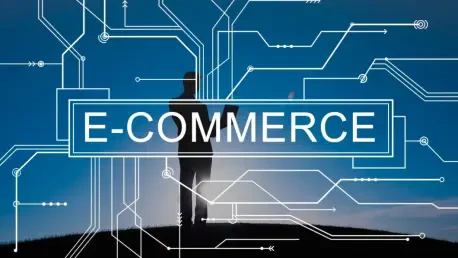The Rise of B2B Ecommerce and Shopify’s Position
In today’s digital economy, B2B ecommerce has emerged as a powerhouse, transforming how businesses transact on a global scale with transactions worth trillions annually. Unlike consumer-focused retail, this sector involves larger order volumes, complex pricing structures, and long-term relationships, making it a critical driver of economic activity. As companies increasingly shift procurement and sales online, the demand for robust platforms that can handle these intricate operations has skyrocketed, setting the stage for innovative players to capture significant market share.
Shopify, traditionally known for empowering small to medium-sized retail businesses, has rapidly positioned itself as a formidable contender in this space. The platform’s adaptability to both retail and wholesale needs, coupled with cutting-edge technological advancements like cloud-based solutions and AI-driven tools, has allowed it to stand out among competitors. With major trends such as digital transformation and the push for seamless integrations shaping the industry, Shopify is carving a niche by addressing the unique demands of enterprise clients while navigating a competitive landscape dominated by legacy B2B software vendors.
This rise is not without context, as the broader industry sees an accelerated shift toward automation and data-driven decision-making. Shopify’s ability to offer scalable solutions that cater to diverse sectors—from consumer goods to industrial services—demonstrates its strategic foresight. By leveraging modern infrastructure and focusing on user-friendly experiences, the company is redefining expectations for what a B2B ecommerce platform can achieve in an increasingly interconnected market.
Shopify’s Explosive Growth in B2B Ecommerce
Key Trends Driving Shopify’s B2B Success
Shopify’s pivot from a primarily retail-focused platform to a hybrid model accommodating both retail and wholesale operations marks a significant strategic evolution. This shift has attracted a wide array of clients, including global giants like Starbucks and industrial leaders such as Boart Longyear. By catering to businesses with complex needs, Shopify has tapped into a segment hungry for flexible, all-in-one solutions that streamline operations across different business models.
A key factor in this success lies in Shopify’s innovative feature set tailored for B2B transactions. Tools like purchase order support, tiered pricing structures, and customer-specific catalogs have become game-changers, enabling enterprises to manage bulk orders and customized deals with ease. Additionally, the integration of artificial intelligence to optimize workflows and enhance user experiences has positioned Shopify as a forward-thinking solution provider in a market often slowed by outdated systems.
Beyond features, Shopify’s focus on accessibility for businesses of varying scales has broadened its appeal. Whether it’s a multinational corporation consolidating multiple ecommerce sites or a mid-sized wholesaler seeking efficient order management, the platform’s versatility addresses pain points that traditional software often overlooks. This adaptability is proving to be a cornerstone of Shopify’s growing influence in the wholesale arena.
Financial Performance and Market Metrics
The numbers behind Shopify’s B2B segment tell a compelling story of growth, with a staggering 101% increase in gross merchandise volume (GMV) in this category during the latest fiscal quarter. This surge is part of a broader financial uptick, as the company reported an overall GMV of $88 billion, reflecting a 31% year-over-year rise. Revenue also climbed by 31% to reach $2.7 billion, underscoring the platform’s robust performance across all sectors.
Regionally, Shopify saw exceptional growth in Europe with a 42% increase in sales, highlighting its expanding international footprint. The success of Shop Pay, the company’s one-click checkout solution, further amplifies this momentum, processing $27 billion in transactions with a 65% growth rate. These metrics, combined with cross-border transactions accounting for 15% of total GMV, point to Shopify’s growing role in facilitating global commerce.
Looking ahead, forecasts suggest continued expansion in the wholesale space, driven by Shopify’s strategic investments and consistent financial health. With 11 consecutive quarters of positive free cash flow and plans to settle significant debt using cash reserves, the company is well-positioned to sustain its aggressive push into new markets. This financial stability provides a strong foundation for scaling B2B operations in the coming years.
Challenges in Scaling B2B Ecommerce for Shopify
Despite its impressive growth, Shopify faces notable challenges in scaling its B2B ecommerce offerings to meet the demands of larger enterprises. Competition from established B2B software vendors with deep-rooted client bases poses a persistent threat, as these players often have decades of experience in handling complex workflows. Shopify must continuously innovate to differentiate itself in a crowded market where loyalty to legacy systems can slow adoption rates.
Integration complexities with enterprise systems represent another hurdle, as many large businesses rely on intricate ERP setups that require seamless compatibility. Addressing this, Shopify has prioritized partnerships and integrations to ensure its platform can sync with existing infrastructures without disrupting operations. However, the process remains resource-intensive and demands ongoing refinement to meet diverse client needs.
Scalability also emerges as a critical concern, with the need to support high-volume transactions and customized solutions for global firms. To tackle this, Shopify is investing in cloud-based technologies to enhance performance and reliability under heavy loads. By focusing on flexible architecture and robust support systems, the company aims to mitigate risks associated with rapid expansion while maintaining service quality for its growing enterprise clientele.
Navigating the Regulatory and Compliance Landscape
Operating in the B2B ecommerce space requires strict adherence to a complex web of regulatory standards, particularly concerning data security and privacy. With businesses handling sensitive customer and transaction information, compliance with global standards such as GDPR in Europe and various data protection laws elsewhere is non-negotiable. Shopify has implemented stringent security protocols to safeguard data, ensuring trust among its enterprise users.
Cross-border trade compliance adds another layer of complexity, as B2B transactions often span multiple jurisdictions with differing tax codes and trade regulations. Shopify’s platform is designed to adapt to these variations, offering tools that help businesses manage compliance requirements efficiently. This capability is crucial for clients engaged in international wholesale, where regulatory missteps can lead to costly penalties or delays.
Payment processing standards also demand attention, given the high-value transactions typical in B2B commerce. Shopify ensures its systems align with industry benchmarks for secure and transparent payment handling, supporting multiple currencies and methods to accommodate global partners. By proactively addressing these regulatory challenges, the company maintains a competitive edge in serving businesses with intricate operational needs.
The Future of Shopify in B2B Ecommerce
Shopify’s forward-looking strategies signal a strong commitment to reshaping B2B commerce through technological innovation. The introduction of AI tools like Sidekick, which assists merchants in analyzing performance metrics, and Universal Cart, enabling seamless multi-store transactions, showcases how the company is leveraging cutting-edge solutions to enhance user experiences. These advancements are poised to redefine efficiency in wholesale operations over the coming years.
Emerging opportunities in enterprise markets also present a promising avenue for growth, as more large-scale businesses seek modern, cloud-based platforms to replace outdated systems. Shopify’s ability to cater to manufacturers, consumer goods firms, and even non-retail sectors positions it to capture a larger share of this segment. Strategic partnerships with industry leaders further amplify its potential to penetrate deeper into specialized markets.
Global expansion remains a key focus, with economic and technological trends favoring digital-first solutions in commerce. As businesses worldwide prioritize agility and scalability, Shopify’s adaptable platform is well-suited to meet these evolving demands. Continued investment in localized features and support for cross-border trade will likely solidify its standing as a go-to solution for international B2B transactions in the near future.
Shopify’s Path to B2B Dominance
Reflecting on Shopify’s journey, the remarkable 101% GMV growth in its B2B segment stands out as a testament to its strategic foresight and adaptability in a competitive landscape. The company’s investments in tailored tools for wholesale operations and its expanding roster of enterprise clients, from consumer brands to industrial firms, highlight a pivotal shift that redefines its market role. Financial strength, underscored by consistent revenue gains and regional successes, further cements its position as a rising force in ecommerce.
Looking back, the challenges of scaling and regulatory navigation were met with innovative solutions like ERP integrations and robust compliance frameworks, which helped Shopify build trust among global businesses. The emphasis on AI-driven tools and cloud-based infrastructure also played a crucial role in addressing enterprise needs, setting a high standard for competitors. These efforts collectively paved the way for sustained momentum in capturing market share.
Moving forward, businesses considering Shopify’s platform should evaluate its scalability and integration capabilities to align with long-term goals, while Shopify itself must prioritize ongoing innovation to stay ahead of legacy vendors. Exploring partnerships with regional players could enhance its global reach, and investing in advanced analytics might offer deeper insights for B2B clients. Ultimately, maintaining a balance between technological advancement and user-centric design will be key to securing dominance in the wholesale ecommerce arena.









